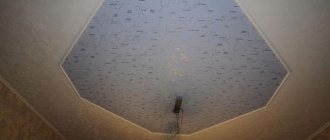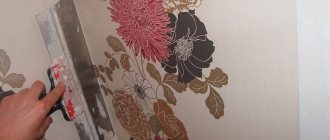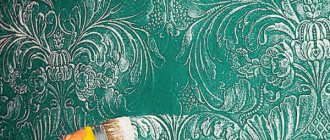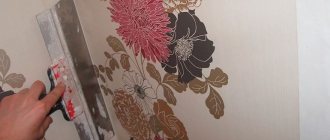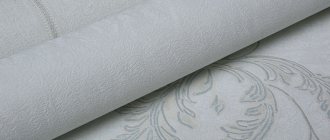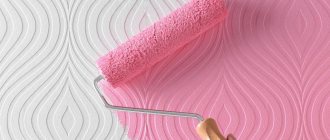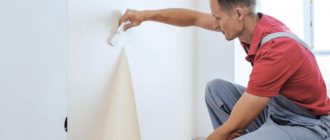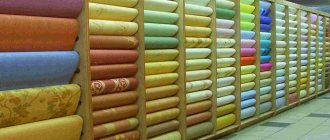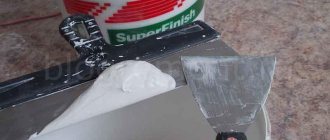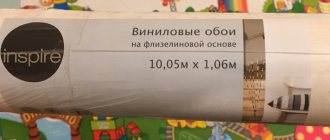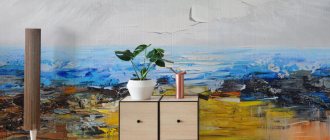One of the advantages of paintable wallpaper is additional sound insulation. Non-woven paintable wallpaper appeared on the market not so long ago, but it has an enviable number of fans. There are wallpapers, the top layer of which is only non-woven; they are usually thin and look quite simple. There are wallpapers with foam vinyl applied on top; they are thicker than just non-woven wallpaper, and their structure looks more advantageous.
Non-woven wallpaper for painting: characteristics
Strict technical specifications in themselves say little; their capabilities and features speak more eloquently about the quality of wallpaper.
Features of non-woven wallpaper:
- It is easier to cover walls with such wallpaper than, for example, paper, if only because the glue is applied only to the wall;
- This wallpaper better smooths out wall defects;
- Finishing a room ultimately takes less time;
- The non-woven base is in any case stronger than paper.
The so-called pure non-woven wallpaper is multi-layered, structural, you can purchase both smooth and embossed. The latter option has more fans
When purchasing wallpaper, make sure that the seller has certificates. When you bring it home, unwrap the roll and see if there is any defect. As long as the wallpaper is not cut, it can be exchanged.
Criteria for choosing wallpaper for painting (video)
How to paint non-woven wallpaper
You can strictly purchase paintable wallpaper from non-woven fabric, but, in principle, any wallpaper with non-woven fabric can be painted. Is it worth doing this if the wallpaper, for example, is smooth, and in fact, except for the color, nothing in the interior will change.
Painting makes more sense when there is an interesting relief on the non-woven fabric, and it is this that can be played up with the help of color.
In order not to spoil the wallpaper with your own hands, it is important to know what kind of paint and what to use to paint the interlining.
After painting, non-woven wallpaper for painting becomes more durable
Is it possible to paint non-woven wallpaper without painting?
It's definitely possible! If the texture and relief are interesting, then you can change the color of the wallpaper. It is not advisable to apply light paint to initially dark wallpaper; yes, in many cases the painting will be successful, but the failure rate is also obvious.
You can also paint wallpaper with a top layer of vinyl, although for some reason many are afraid to deal with such wallpaper that cannot be painted. The main condition here is high-quality wallpapering, so that after applying a new decorative layer, they do not begin to fall off.
Paint for non-woven wallpaper for painting
Which dye to choose? By the way, you don’t have much choice. The main requirement for paint is that it must be water-dispersion based.
You can finally decide on the color of the paint only when the wallpaper is already pasted on the wall.
What colors are suitable:
- Acrylic;
- Water-based;
- Latex.
Latex mixtures would be an ideal option, but their prices are steep. The best analogue to them is acrylic paints.
How to paint wallpaper for painting (video)
Paint for vinyl wallpaper on non-woven fabric
And here the answer will not be different - you need to take the same water-dispersed paints. There is an opportunity, buy latex. What makes latex composition convenient is its quick readiness for use. Five, maximum six hours after applying this paint, the wall is ready to serve you - that is, it will actually dry.
Once again, it’s worth reminding: don’t believe the myth that comes from nowhere that you can’t paint vinyl with water-based paints. Only they can do it!
If there are many defects
What to do in cases where there are many problem areas? If the entire finishing area has flaws, then the answer to the question whether it is possible to paint non-woven wallpaper in this condition will be negative. The procedure for applying a new coating is not very complicated. It is not necessary to invite masters for this, since everyone can do it themselves. But don't neglect useful information. Each step must be completed flawlessly.
Non-woven wallpaper for painting: reviews
If you analyze the reviews, most are positive.
Non-woven wallpaper is considered an environmentally friendly and hypoallergenic finishing material
Most often you can see such comments on special forums:
- The most interesting and good thing is that such wallpaper can be repainted often - whatever color scheme you want, you choose that color, and you can repaint it up to ten times;
- Paint only after complete drying, you need to be patient for a couple of days, and then you will be pleased with the result;
- Good paints on acrylate - no smell, no harm, easy to work with;
- The rolls are wide, gluing is quick, and painting is also easy.
Among the negative reviews you can very often see where people complain about poor painting. But this is often due to the wrong choice of paint and too thin a layer of paint.
Useful tips
Of course, manufacturers indicate that materials can be painted up to 20 times, but in reality everything is not so simple. It is better to do no more than 6 stains, otherwise the material will gradually begin to wear out and lose its newness.
If applying a lighter tone, apply the white coat first. This will avoid uneven shades. This will ensure a more even application.
In addition, about 200-250 grams of the composition are usually used per square meter of surface. Based on these numbers, you can calculate the required number of cans. It is better to buy them with a small reserve, as some difficulties may arise in the process.
Is it possible to glue non-woven wallpaper onto paint?
The important point here is whether you know what kind of paint is applied to the wall.
Non-woven wallpaper for tinting goes on sale in neutral shades. But there is a huge selection of textures
Types of paints and the possibility of gluing non-woven wallpaper:
- Acrylic paint . The surface needs to be prepared - treat the wall with a mixture of primer and solvent, this composition will create small depressions on the wall, which are necessary for high-quality fixation of the glue.
- Oil paint . Without treating the wall, nothing will come of it either. Use coarse sandpaper to create uneven surfaces and finish with a primer coat.
- Water-based paint . Again, treat the surface with sandpaper and prime the wall. In this case, use a primer that has anti-mold and antifungal additives.
As you can see, you cannot glue wallpaper without treating the walls. Take the time to prepare the wall; good preliminary work will ensure good adhesion to the adhesive.
Varnish coating
Many craftsmen decide to use varnish to cover the walls, this is justified by several factors:
- Sophisticated look. The appearance of the wall is transformed and acquires a glossy shade , and the color of the wallpaper changes slightly.
- The varnish increases the resistance of the material to mechanical damage and accidental abrasion of the surface.
- Additional water resistance. After covering the product with a varnish solution, you can carry out any work to remove dust and dirt with a wet cloth and not worry about damaging the paint structure.
It is important to know that after the varnish layer has dried, unpleasant moments may appear on the wall:
- if there were defects and scratches on the wall, then when it is covered with a layer of varnish, the irregularities will become more noticeable and clearer than before;
- without varnish, wallpaper can be removed from the wall if such a need arises, and after varnish this process will turn into a painful task;
- the varnish solution after drying or even during the application process can seriously damage the joints and edges of the canvas;
- there is a high probability that the composition will show through the wall.
When working with varnish, it is important to know that it is applied to a pre-painted wall surface.
Painting non-woven wallpaper with water-based paint
Whatever painting method you use, the features of painting with water-based paint will be the same.
The paint is applied with a roller. Don’t rush to use a lot of paint - it can lead to smudges, and very thick paint will hardly fill the picture
Painting with water-based paint:
- Does not require preliminary priming;
- The wallpaper must be cleaned of dust and dried;
- Cover all adjacent surfaces with wide tape to prevent paint from getting on them;
- Protect the ceiling from accidentally touching the paint.
Do not put too much pressure on the roller, as you can damage the surface of the non-woven material. The direction of the roller over the entire surface should be the same.
Painting non-woven wallpaper (video)
Required Tools
— Paint container
— Roller tray with reservoir
— Velor or fur roller
— Pieces of foam rubber (sponges)
— Brushes
How to glue non-woven wallpaper for painting
Gluing any wallpaper on non-woven fabric is very easy, faster than paper wallpaper. And it doesn’t matter whether they are intended for painting or not.
Non-woven wallpaper for painting is somewhat easier to glue than paper wallpaper, since the glue is applied only to the walls
Tips for wallpapering non-woven fabric:
- Use glue designed for gluing this type of wallpaper;
- Do not apply glue to the entire wall at once, only to the area that will be pasted over right now;
- There is no need to impregnate the strips themselves with glue;
- Start gluing “from the light,” that is, from the window;
- The verticality of the first canvas, which must be perfect, is checked by a level.
In all other respects, the gluing method is similar to the traditional one.
Wallpapering for painting (video)
Non-woven wallpaper for painting is a smart investment. You can repaint them at least six times, thereby changing the image of the room. Choose beautiful, good quality embossed wallpaper and create the color mood of the room yourself.
Happy renovation!
What you need for painting
Before you start painting, prepare the necessary tools and equipment.
- paint rollers;
- brushes;
- cuvette or paint tray;
- masking tape;
- stepladder;
- a rag to remove splashes.
Before you begin, prepare your tool
We should also talk about rollers - this is the main tool for painting work. They differ in size and material of manufacture:
- foam;
- velor (short pile);
- fur (with long and medium pile).
For simple painting you will need two rollers: a small one and a large one. Small ones are convenient for painting the outline, large ones do the main work.
To paint textured wallpaper to the full depth of the pattern, you will need a roller with a pile of 1.5-1.8 cm. A velor roller with short pile will help to roll only the pattern. For this purpose, you can also use foam rubber, but when painted it leaves bubbles on the surface.
The relief pattern is painted over with a long-nap roller
The brush is used for painting hard-to-reach areas where working with a roller is impossible. These are corners, crevices, areas behind pipes. It also paints the outline of the ceiling and floor.
You will need adhesive tape to protect ceiling skirting boards, sockets, pipes, window slopes, and so on. If the walls will be painted in two or more colors, use tape to mark the border.
Paint is poured into the cuvette or tray. The ribbed surface helps to completely saturate the roller and remove excess paint from it.
Before pouring paint into the cuvette, place a bag over it. You don't have to wash the bath after work.
Non-woven wallpaper for interior painting (photo)
Related article: Internal wall insulation with foam plastic - technology
